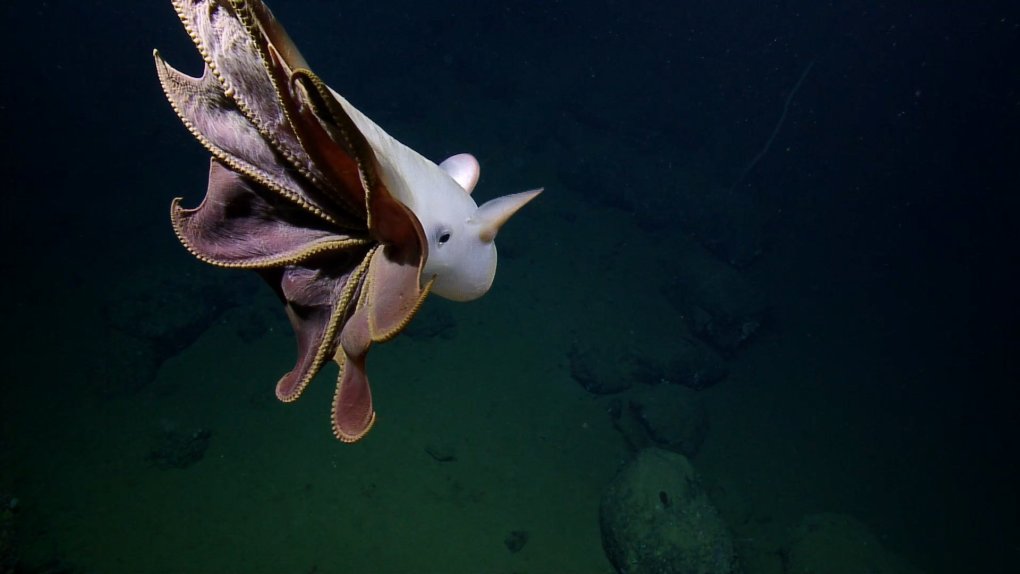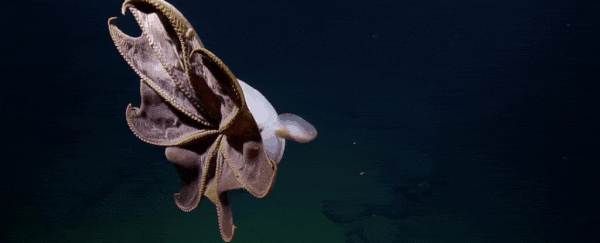
This year’s Halloween experience was elevated by several spooky surprises from nature. First, there was news of the “Death Comet’s” November 11 Earth flyby. Then, on October 23, 2018, scientists aboard the E/V Nautilus stumbled upon a white octopus with translucent “wings” that looked more like a ghost from outer space than the eight-legged mollusks we are accustomed to seeing.
The cephalopod’s scientific name is Grimpoteuthis. However, thanks to the two ear-like fins on the sides of its body that it uses to navigate across the water, it is better known as the dumbo octopus, after Disney’s animated elephant. The sea animal also has eight legs connected to its body by a web of skin, which are used to accelerate the pace when faced with predators such as tunas or sharks. Dumbos can also crawl across the seafloor using their tentacles.
While the specimen caught on tape was mostly white, dumbos, like all other octopuses, can change their skin color at will to blend in with the environment. They, however, do not produce ink, often used as a defense mechanism by other octopuses. Instead, some Dumbo species have developed sharp spines on their tentacles.

There are more than a dozen known species of dumbos. While most are small, measuring between 8 and 12 inches long, some can reach upwards of 6 feet in length. Though the mollusks have huge, bulging eyes they can barely see. However, given that dumbos dwell in the deepest, darkest parts of the Atlantic and Pacific Oceans, where nothing is visible, the lack of sight does not hinder them. Instead, they have learned to use the suckers on their tentacles to feel their surroundings.
Their deep-sea habitat makes the cephalopods difficult to spot, which is why any sighting of the extraordinary animals is met with such joy. The latest specimen, captured on camera by Hercules, E/V Nautilus's unmanned robotic submersible (ROV), was discovered two miles underwater around the Davidson Seamount, an extinct volcano in California’s Monterey Bay National Marine Sanctuary.
As the beautiful creature came into sight, the scientists giddily exclaimed, “Oh, my, it’s so cute,” and “I love me a good cephalopod” and “the world loves a dumbo.” As though it could hear them, the octopus, which had been calmly flapping its two large fins, decided to put up a show by opening up its tentacles to reveal the umbrella-like appearance of its legs. The performance caused additional excitement. “Yeah, he's a show-off," one delighted team member said. "You're going to be famous," said another.

The dumbo octopus was not the only thrilling discovery caught on tape by the ROV recently. A few days after the rare cephalopod was spotted, Hercules came across a massive nesting ground where over a thousand deep-sea octopuses were huddled in the rocks with their eggs. Even more interesting, were the fields of 10-foot-tall pink bubblegum corals and sponges that Chad King, Nautilus’ chief scientist, described as “something right out of a Dr. Seuss book.” Given that the area is believed to be teeming with life, we wonder what other fascinating creatures the scientist will uncover next.
Resources: Natgeo.com, ipfactly.com, livescience.com
